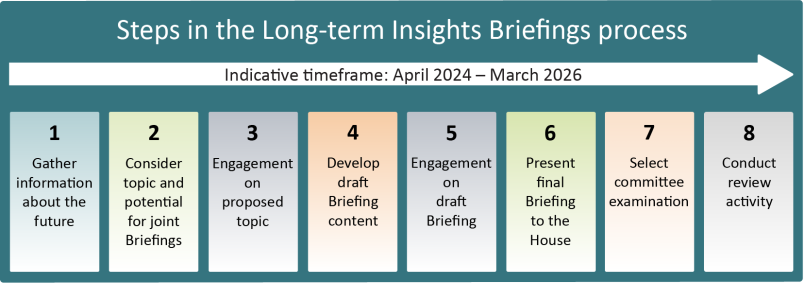
iStock image - credit: DaLiu
The New Zealand Public Service has a duty of stewardship, to look ahead and provide advice on future challenges and opportunities. This requires a Public Service that values foresight – to think, anticipate, and act in the future interests of people in New Zealand.
To achieve this, the Public Service Act 2020 (Schedule 6, clauses 8 and 9) requires departmental chief executives to publish a Long-term Insights Briefing (Briefing) at least once every three years. The Briefings are think pieces on the future, not government policy, and are developed independently of ministers.
The purpose of the Briefings is to make publicly available:
- information about medium and long-term trends, risks and opportunities that affect or may affect New Zealand and New Zealand society
- information and impartial analysis, including policy options for responding to these matters.
Guidance materials
Since the first round of Briefings that concluded in mid-2023, the guidance has been refined and updated with lessons learned and good practice examples. They also include details on the supporting role played by the Policy Profession Board during the next Briefing round.
1. Process guide
This sets out the requirements on departmental chief executives to develop a Briefing and provides recommendations to help with development. It includes guiding principles, criteria to help with topic selection, public messaging, and a list of information sources.
2. Overview of steps
This overview sets out the high-level steps and indicative timeframes for departments to follow in developing their Briefings.

3. Checklists
This guide sets out the activities in each of the eight steps for managers and teams developing a Briefing. Checklists under each step set out practical actions that can be taken to develop and deliver a high-quality Briefing.
Review of the first round of Briefings
The Department of the Prime Minister and Cabinet undertook a review of the first round of Long-term Insights Briefings (Briefings) in July and August 2023. The review assessed what went well, what didn’t go so well, and identified improvements for future rounds. The review focused on the process to develop Briefings – it didn't assess their quality or how they might influence longer-term policy.
Agency Briefings and approaches
Nineteen Long-term Insights Briefings were published in the first round – four produced jointly between multiple agencies. Topics ranged from broad to narrow (e.g. from imprisonment to the use of block chain technology). See the page Published Briefings for more information and links to these publications.
Review findings
- System-wide review of the process for the first round of Long-term Insights Briefings
See this A3 for a summary of the review findings.
Agencies found the Briefings provided an opportunity to:
- give visibility to important topics across agencies and externally
- influence departments’ workstreams and strategic intentions
- encourage collaboration across agencies and with stakeholders
- build new skills within their agencies – futures thinking, engagement and communication.
Challenges for agencies in developing their Briefings included:
- deciding on the scope of subject matter
- the resource implications of conducting two consultation rounds
- trying to separate the department’s day to day thinking from long-term thinking
- the time and resources needed to support the development of their Briefings.
The guidance for the second round of Briefings reflects the findings from the review.
The next round of Briefings
We provide guidance for the development of Long-term Insight Briefings. This guidance will be updated to include best practice examples and a lessons-learned section.
The Policy Profession Board will assist in the development of the next round of Briefings. This will include providing information on New Zealand’s key long-run trends and challenges and supporting discussions between agencies on briefing topics.
Other resources
We also encourage you to check out our:
- Futures thinking tools in the Policy Methods Toolbox. Futures thinking provides a range of techniques that can be used in developing a Long-term Insights Briefing to help you think about the drivers of change that are shaping the future.
- Community engagement tools in the Policy Methods Toolbox. The Public Service Act 2020 requires departments to consult the public on the subject matter of the Briefing and the draft Briefing once developed.
- Stewardship page which provides information and resources to help you get a better understanding of stewardship in the context of policy advice, and why it’s so important.
Where to go for help
Individuals and teams working on Briefings in government agencies can join a Microsoft Teams group. The purpose of the group is to share information collected as part of the Briefing process and connect with people in other departments who are developing the Briefings. To join the group, email the Policy Project.
The Policy Project is also available to answer any questions related to the Long-term Insights Briefings and guidance. You can contact us at [email protected].
